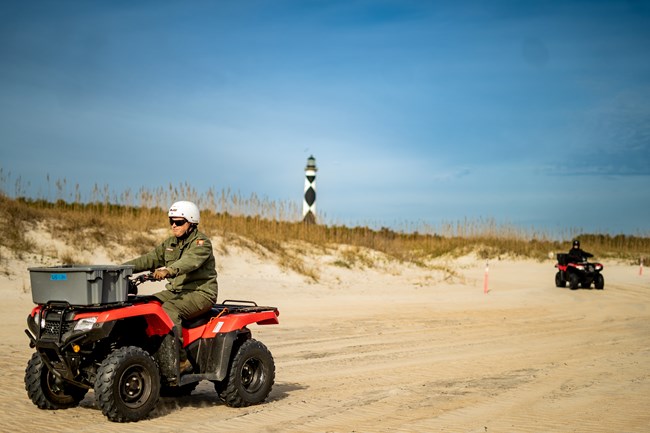Off-Road Vehilce PermitBringing your vehicle to the beach this season? Don’t forget to purchase your ORV (Off-Road Vehicle) permit! ORV permits must be purchased online through Recreation.gov. To obtain an ORV permit, your vehicle must:

NPS Photo If you purchase your ORV permit between January 1st - February 28th your ORV decal will be sent to you in the mail. Be sure to include your mailing address when purchasing your permit. For ORV permits purchased on or after March 1st, your decal will be issued upon arrival on the islands. They can only be issued at the Great Island Cabin Camp Office (daily from 8:00 am to 3:00 pm), the Harkers Island Visitor Center (email to schedule an appointment), or by Law Enforcement Park Rangers upon showing the printed ORV Permit purchased from Recreation.gov. Failure to have the window decal while driving on the island may result in a citation. Decal must be displayed on driver's side left top corner of the windshield or the front left fender on an ATV/UTV. 
NPS/Sabrina Godin Additional Information: Be aware that the Cape Lookout National Seashore ORV Driving Permit is not the same as the ORV permit purchased for Cape Hatteras National Seashore. Long term parking is not included with the purchase of an ORV permit. If you are going to leave your vehicle in one of the long-term parking lots, you still need to obtain a long-term parking permit.
Visit our keyboard shortcuts docs for details
Information on safely driving on the beaches and sand trails of the barrier islands within Cape Lookout National Seashore. This video must be viewed as part of obtaining an ORV driving permit for the barrier islands within the park. Questions about Off-Road Vehicles Permits?Contact us by email.Frequently Asked Questions Before you bring your vehicle to the islands, read through the frequently asked questions to esnure you know all the driving regulations
Speed limit is 25 mph, unless otherwise posted. Slow down when passing vehicles parked on the beach as they may have young children or pets that may dart out from the vehicles without seeing you.
Driving in or on the dunes is prohibited. Parking in between dunes is prohibited. This includes campers, trailers, etc. Driving or parking on vegetation is prohibited.
Passengers riding in the beds of pickups and UTVs MUST sit flat on the bed of the truck and not on side rails, wheel wells, camp chairs, coolers, etc.
You must wear your seatbelts while riding in vehicles and UTVs
Cape Lookout National Seashore does not have electric vehicle charging stations. If you are planning to bring an electric vehicle to South or North Core Banks, please plan accordingly.
Recommended equipment within the vehicle includes: low-pressure tire gauge, shovel, jack and jack support board.
Before driving on designated off-road vehicle routes, Cape Lookout National Seashore strongly recommends that tire pressure be lowered to 15-20 PSI. The softer the sand, the lower the pressure needed. Re-inflate tires to normal pressure after returning to paved roads. Many local businesses have air pumps. Optional equipment includes a full-sized spare tire, first-aid kit, fire extinguisher, trash bag or container, flashlight (if night driving) and tow strap. You cannot have any open containers of alcohol anywhere in the vehicle, including in the bed of a truck or UTV
ATV operators must be at least 16 years of age, wear a DOT approved helmet, wear safety glasses/goggles, and have only the manufacturer’s recommended number of riders.
Beach fires must be below the high tide line and no more than 3 feet in diameter. Beach fires must be fully extinguished with water. If you have a fully contained fire pit or stove, you may have it between the high tide line and the dune line, but not within the dunes.
Camping for more than 14 consecutive days is prohibited.
Pets must be restrained on a leash not to exceed 6 feet or otherwise confined at all times. Pets are prohibited within any resource protection zone closure.
Driving on beaches or back road at night with accessory light bars illuminated is prohibited.
Fireworks are prohibited.
Metal detectors are prohibited
Drones are prohibited
Do not drive between vehicles parked near the water line and the ocean. You may snag a fishing rod line.
When parked on the beach, leave room for two-way traffic to pass safely. Park along the shoreline in a single row of vehicles no more than one vehicle deep. Stay informed about current and anticipated weather conditions and high tide events. Some sections of beach become impassable during high tide. Do not attempt to drive through any wildlife closures, or along the water’s edge in front of closures. For ramp-to-ramp closures, you must detour to the back road; for partial closures, you must drive behind the closure, along the edge of the dunes. Do not approach, feed, or disturb any wildlife. Report beached marine mammals to the National Park Service. Reckless driving, such as cutting circles, throwing sand into the air, or defacing the beach is prohibited.
Sound side driving is prohibited. Parking in between dunes is prohibited. This includes campers, trailers, etc. Driving or parking on vegetation is prohibited. |
Last updated: August 12, 2025
